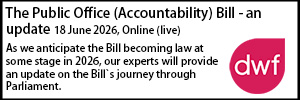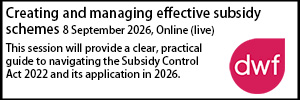Procurement claims, sub-contractors and standing
- Details
The High Court recently dismissed a procurement claim over the award of the licence to run the National Lottery. James Neill and Barney McCay explain why.
The High Court has dismissed a significant claim for damages arising from the Gambling Commission’s competitive tender for the Fourth National Lottery Licence. In doing so, it has delivered an important judgment on the standing of sub-contractors to bring such claims.
In April 2022, the incumbent operator of the National Lottery (“Camelot”) and its proposed sub-contractors and sub-sub-contractors (“the IGT claimants”) challenged the Commission’s decision to award the Fourth Licence to Allwyn Entertainment Ltd. Although the claimants failed to prevent the Commission from concluding the contract with Allwyn, they continued to sue the Commission for damages under the Concession Contracts Regulations 2016 (“CCR 2016”).
Camelot withdrew its claim earlier this year. But the IGT claimants maintained their claim. So, in advance of the liability trial, the High Court was asked to determine whether the IGT claimants had standing to bring such a claim under the CCR 2016. The High Court concluded that they did not. Sitting in the Technology and Construction Court, Coulson LJ held that:
- The EU Remedies Directive did not oblige the UK to confer standing to bring a procurement challenge on potential sub-contractors. This was clear from the language of Art. 1(3) of the Directive, the travaux préparatoires, and CJEU and Irish case law.
- A review of the history of the transposition of the EU procurement directives into domestic law made clear that the UK had not intended to “gold plate” the CCR 2016 and go further than its obligations under EU law. Although Coulson LJ considered this exercise to be like “chewing through an extremely soggy biscuit”, the Judge thought that the lack of gold-plating was the “small dollop of jam in the middle” that was of “critical significance in this case” because it indicated that the UK had not intended to confer standing upon sub-contractors. So on a purposive interpretation of the CCR 2016, none of the IGT claimants had standing to sue the Commission for damages.
- Coulson LJ held that even if the CCR 2016 could be interpreted without reference to EU law and a purposive approach was not adopted, the IGT claimants still lacked standing. The claimants could not be characterised as “economic operators” within the meaning of the CCR 2016. This was clear from the case law, the language of the statutory provisions, and the operation of the statutory regime as a whole. Indeed, in Coulson LJ’s view, “absurd results” would follow if a contrary interpretation was adopted.
- Lastly, Coulson LJ considered that one of the IGT claimants also lacked standing because, as a US company, it was only entitled to bring a claim if the World Trade Organisation’s Government Procurement Agreement (“GPA”) applied to the “procurement concerned”. The GPA did not apply to the “procurement concerned” in this case: the GPA only applied if the procurement was specified in a party’s coverage schedule, and the annexes of the EU’s GPA coverage schedule covered neither lottery services nor services concessions contracts.
Although the case interpreted the CCR 2016, which will be replaced by the (soon to be enacted) Procurement Act, it may be relevant to future procurement challenges. It is the first time the courts have considered the scope of the WTO’s GPA, to which the UK is now signatory in its own right.
A copy of the judgment can be found here.
James Neill and Barney McCay are barristers at Landmark Chambers. Together with Rose Grogan of 39 Essex Chambers, they acted for the successful defendant, the Gambling Commission, led by Sarah Hannaford KC of Keating Chambers. They were instructed by Capital Law on behalf of the Gambling Commission and worked with a team from Hogan Lovells led by Rupert Sydenham, Jennifer Dickey, Anne Littlewood and Mariel Hoare.
Sponsored articles
Walker Morris supports Tower Hamlets Council in first known Remediation Contribution Order application issued by local authority
Unlocking legal talent
Legal Director - Government and Public Sector
Contracts Lawyer
Lawyer (Planning and Regulatory)
Locums
Poll
15-07-2026 11:00 am













































